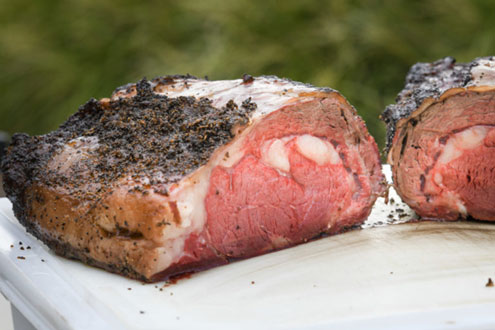Beef consumers should be seeing lower prices on beef, whether steaks or ground chuck, at grocery stores as production increased and wholesale prices continue to decline, said a Texas A&M AgriLife Extension Service expert.
David Anderson, Ph.D., AgriLife Extension economist, College Station, said the U.S. Department of Agriculture retail market report showed prices on beef and other meats are moving downward.
Retail choice beef of all cuts – steaks to ground chuck – averaged $6.84 per pound in July compared to $7.56 per pound in June, he said. However, prices are still higher than this time last year when choice beef averaged $6.07 per pound.
“Even though they’re coming down, we’re way above prices at this time a year ago,” he said.

Anderson said the price decline for beef at grocers reflects a lower wholesale price trend. Retail prices for pork and chicken also slipped since June.
Wholesale choice beef cutout value was $2.05 per pound last week, basically where it was before COVID-19, he said. Wholesale prices were falling, and retail prices are just now catching up.
Despite wholesale prices dipping, COVID-19 restrictions continue to contribute to retail prices being higher than a year ago, Anderson said.
“Restaurants are still not open or open at full capacity, so there is stronger demand at the grocery store for beef,” he said. “There is more costs to put products on shelves, packaging and demand for different cuts compared to restaurants, adjustments to how the stores operate, and stores don’t have an incentive to lower prices if the product is in high demand.”
Anderson said research shows lower prices can be delayed between wholesalers and the consumers. Retail prices go up quicker than they come down.
“There’s research on what’s called asymmetric prices – they don’t go up and down at the same pace,” he said. “There’s a term ‘sticky prices,’ regarding grocery store prices that may be higher than expected considering wholesale prices, but that are nevertheless going down as data suggests. As buyer we’d like to see them come down quicker.”
Calf prices improving
Calf prices are trending higher for 500-600-pound steers yet still a little lower than pre-COVID-19 prices, but Anderson said that could be seasonal. March prices are typically higher compared to mid-summer. And calf prices have been steadily climbing since before the pandemic.
Anderson said there is a demand for cattle, and lower corn and feed prices than a year ago adds more value to maintaining herds.
“Calf prices are better, and we aren’t seeing emerging drought in parts of the state leading to large runs of cattle that might affect prices negatively,” he said. “That could change in the coming weeks without rain.”
Drought monitors show extreme drought continues in parts of West Texas and the southern Panhandle, but much of North and Central Texas has been trending toward drought conditions due to lack of rain and triple-digit temperatures.
If that trend continues, Anderson said culling could flood local markets and lead to price declines for producers.
If calf and cattle prices continue their steady climb or begin dropping due to cattle sell-offs in drought-stricken parts of the state, the ripple effect likely won’t reach consumers anytime soon.
“We shouldn’t see any sharp price adjustments,” he said. “Beef prices are moving the direction they should for consumers and producers, but with restaurants dealing with the pandemic, a large number of unemployed Americans, a huge reduction in GDP, those recessionary impacts plus increasing meat supplies should reflect lower prices at the register.”